How to Connect Data Governance to Business Objectives
Align Data Governance with your business objectives to achieve organizational success. When you integrate the ingredients of data governance into your core strategies, you reduce data-related errors by 50% and save up to 20% in operational costs. This alignment ensures better decision-making, enhances operational efficiency, and strengthens compliance with regulations like GDPR or HIPAA. Without it, you risk wasted resources, missed opportunities, and potential fines from non-compliance. Effective governance also builds trust in your data, enabling you to make informed decisions that drive long-term success.
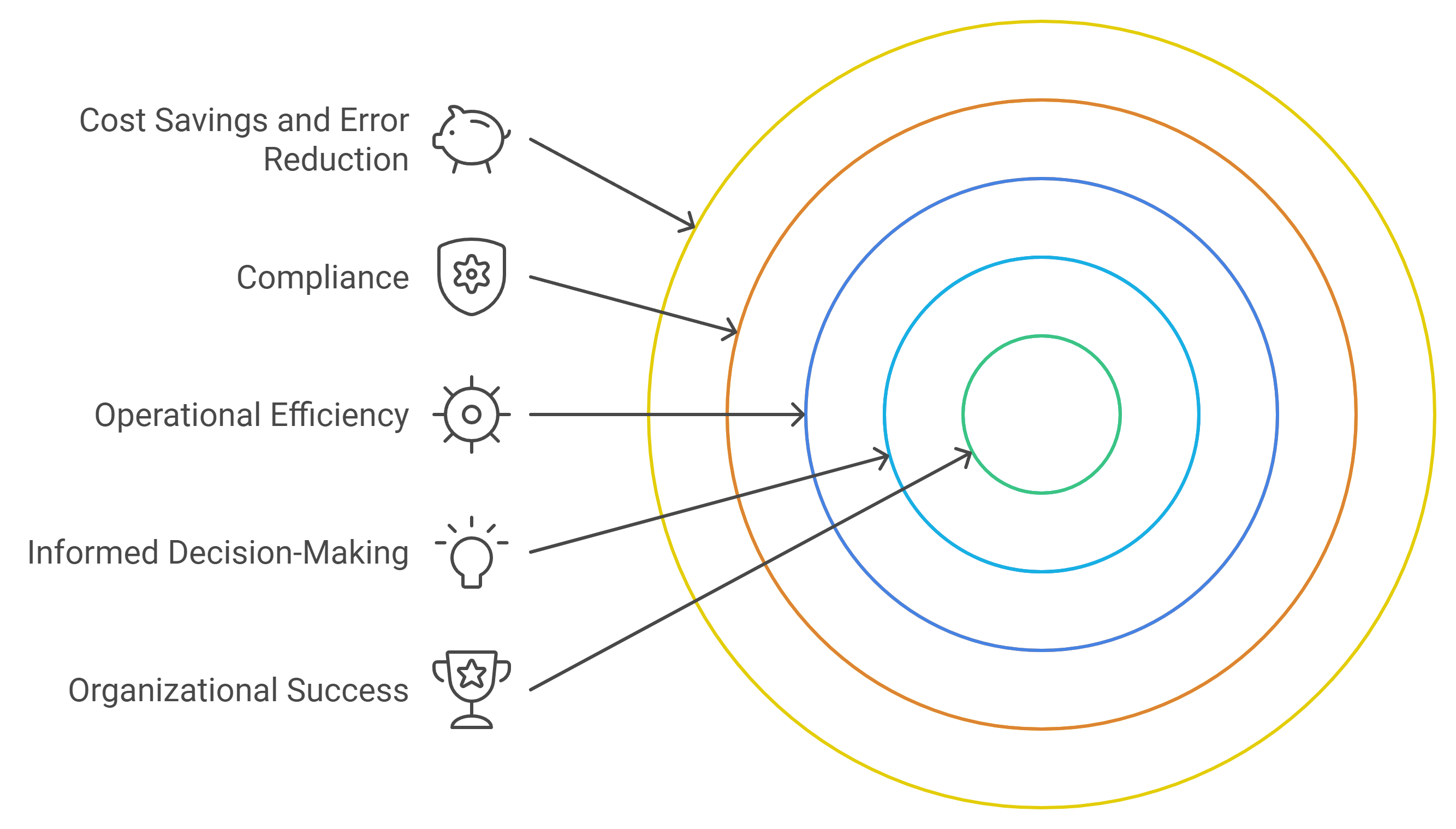
Key Takeaways
Aligning data governance with business objectives can reduce data-related errors by 50% and save up to 20% in operational costs.
Establish a clear governance framework that reflects your organization's core goals to enhance decision-making and operational efficiency.
Involve key stakeholders from various departments early in the process to foster ownership and commitment to data governance initiatives.
Regularly conduct audits and benchmark against industry standards to identify areas for improvement in your data governance practices.
Define clear roles and responsibilities within your governance framework to ensure effective management and accountability.
Promote a culture of collaboration and transparency to break down data silos and enhance data sharing across departments.
Measure the impact of your data governance efforts using Key Performance Indicators (KPIs) to demonstrate value and drive continuous improvement.
Understanding the Role of Data Governance in Business Success
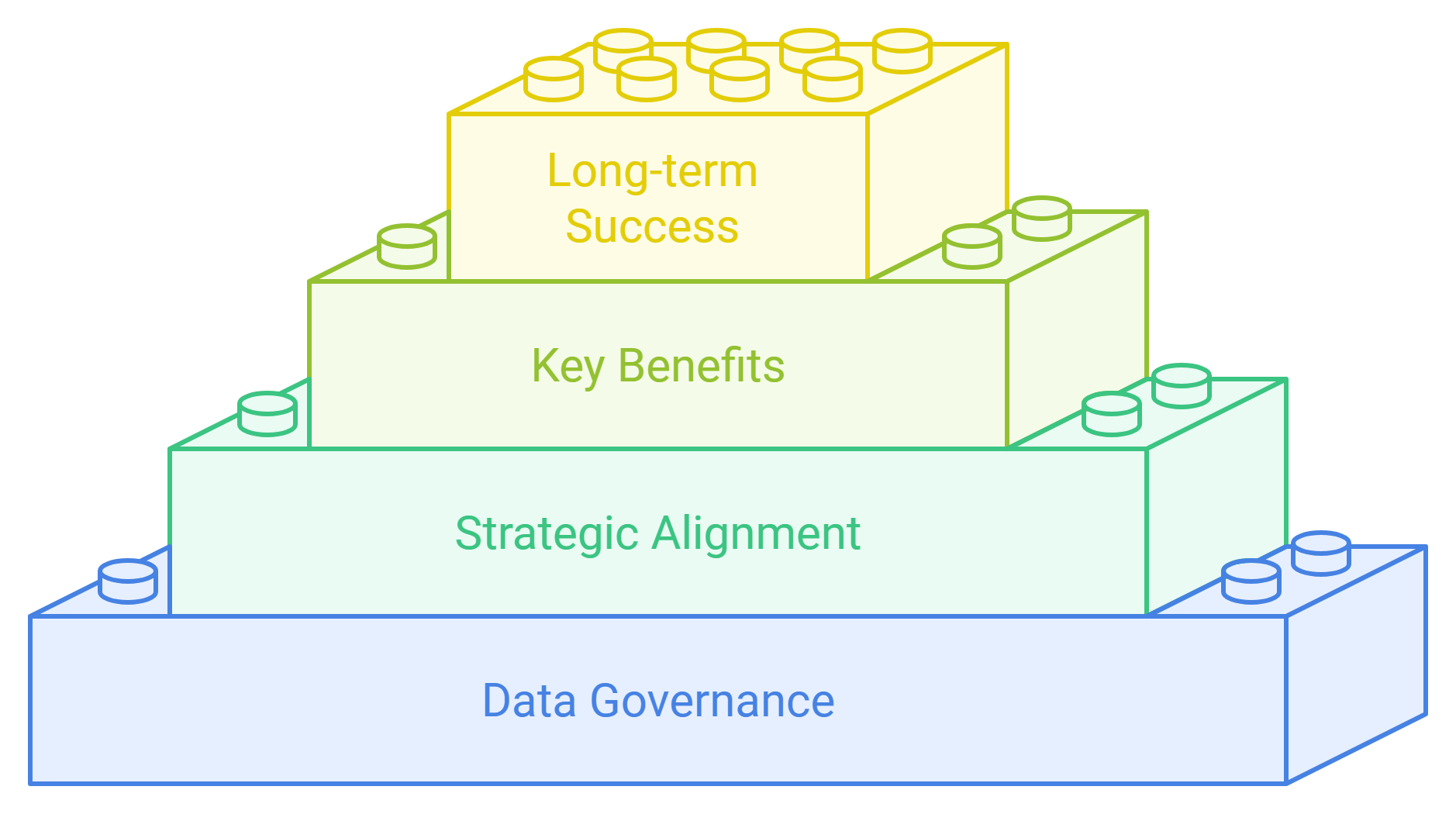
What Is Data Governance?
Data governance refers to the framework and processes that ensure your organization manages its data securely, accurately, and effectively throughout its lifecycle. It involves setting standards, implementing security protocols, and following ethical practices to maintain data quality and reliability. By establishing clear policies, you can ensure that your data remains consistent, trustworthy, and accessible for decision-making.
Good data governance focuses on making data available, usable, and secure. It ensures that your organization can rely on accurate and reliable information to drive business decisions. For example, when you manage data properly, you avoid inconsistencies that could lead to operational or analytical errors. This process not only safeguards your data but also enhances its value as a strategic asset.
Why Data Governance Matters for Business Objectives
Data governance plays a critical role in helping you achieve your business goals. It aligns your data-related activities with your overall strategy, ensuring that every piece of information contributes to your success. When you align data governance with your business objectives, you unlock several benefits:
Improved Decision-Making: High-quality data enables you to make informed decisions. With accurate and consistent data, you reduce the risk of errors and gain insights that drive growth.
Enhanced Efficiency: Proper governance eliminates redundancies and streamlines operations. By managing data effectively, you save time and resources while improving productivity.
Strengthened Compliance: Data governance ensures that your organization adheres to laws and regulations, such as GDPR or HIPAA. This reduces the risk of fines and builds trust with stakeholders.
"Data governance provides superior data management, quality, visibility, security, and compliance capabilities across the organization."
By leveraging data as a strategic asset, you can improve efficiency, drive digital transformation, and create new growth opportunities. Effective governance also protects your organization from data breaches and ensures compliance with industry standards. When you prioritize data governance, you build a foundation for long-term success.
How to Align Data Governance with Business Objectives
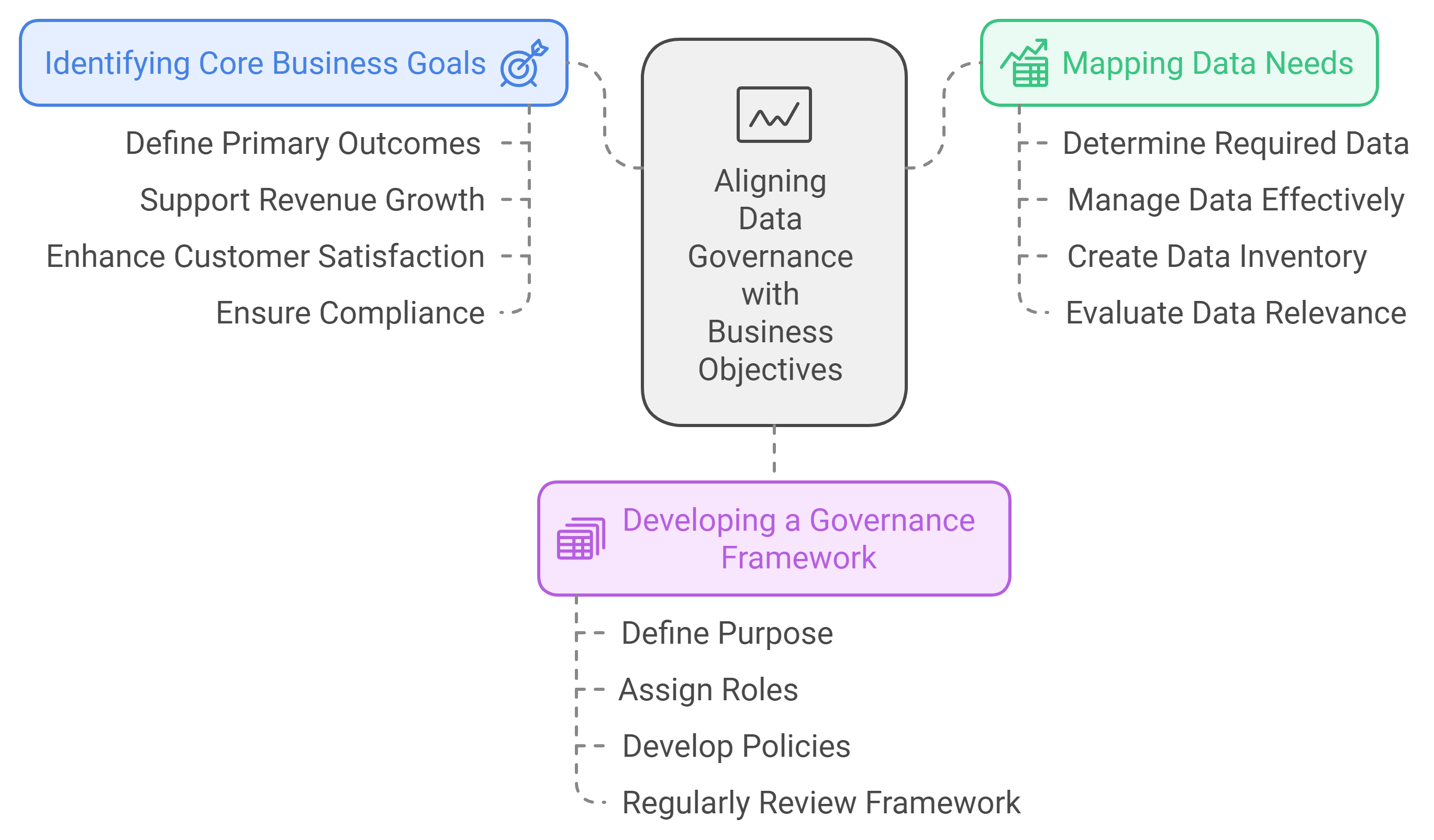
Identifying Core Business Goals
To align data governance with your business objectives, you must first identify your organization’s core goals. These goals act as the foundation for your governance strategy. Start by asking, “What are the primary outcomes my organization wants to achieve?” Whether it’s increasing revenue, improving customer satisfaction, or enhancing operational efficiency, your data governance efforts should directly support these objectives.
For example, if your goal is to improve customer satisfaction, focus on ensuring that customer data is accurate, accessible, and secure. This allows you to deliver personalized experiences and build trust with your customers. Similarly, if compliance is a priority, your governance framework should emphasize adherence to regulations like GDPR or HIPAA. By clearly defining your goals, you create a roadmap that ensures your data governance initiatives contribute to measurable business outcomes.
"Defining a clear vision and objectives for data governance is essential to ensure alignment with the organization’s overall business strategy and goals."
Mapping Data Needs to Business Objectives
Once you’ve identified your core goals, the next step is to map your data needs to these objectives. This involves determining what data is required to achieve each goal and how it should be managed. For instance, if your objective is to enhance decision-making, you need high-quality, real-time data that provides actionable insights. On the other hand, if cost reduction is a priority, focus on eliminating redundant data and streamlining data management processes.
Create a detailed inventory of your data assets and evaluate their relevance to your business objectives. Ask yourself questions like, “Does this data support our goals?” and “Are there gaps in the data we need?” This process helps you prioritize data governance efforts and ensures that your resources are allocated effectively. By aligning your data needs with your objectives, you maximize the value of your data and avoid wasting resources on irrelevant or low-priority data.
Developing a Governance Framework That Reflects Business Priorities
A governance framework serves as the backbone of your data strategy. To ensure alignment with your business objectives, this framework must reflect your organization’s priorities. Begin by defining the purpose of your data governance program. Is it to enhance data quality, ensure compliance, or drive data-driven decision-making? Your answer will shape the structure and policies of your framework.
Establish clear roles and responsibilities within your governance framework. Assign accountability for data management tasks and create a steering committee or governance council to oversee the program. Develop policies around data privacy, security, and access that align with your business goals. For example, if your organization values agility, design policies that balance governance with flexibility.
"Aligning data governance with strategic priorities ensures that data governance objectives resonate with organizational goals and ambitions."
Regularly review and update your governance framework to adapt to changing business needs. This ensures that your data governance efforts remain relevant and continue to support your objectives. A well-designed framework not only aligns data governance with your business priorities but also fosters a culture of accountability and collaboration across your organization.
Assessing and Improving Current Data Governance Practices
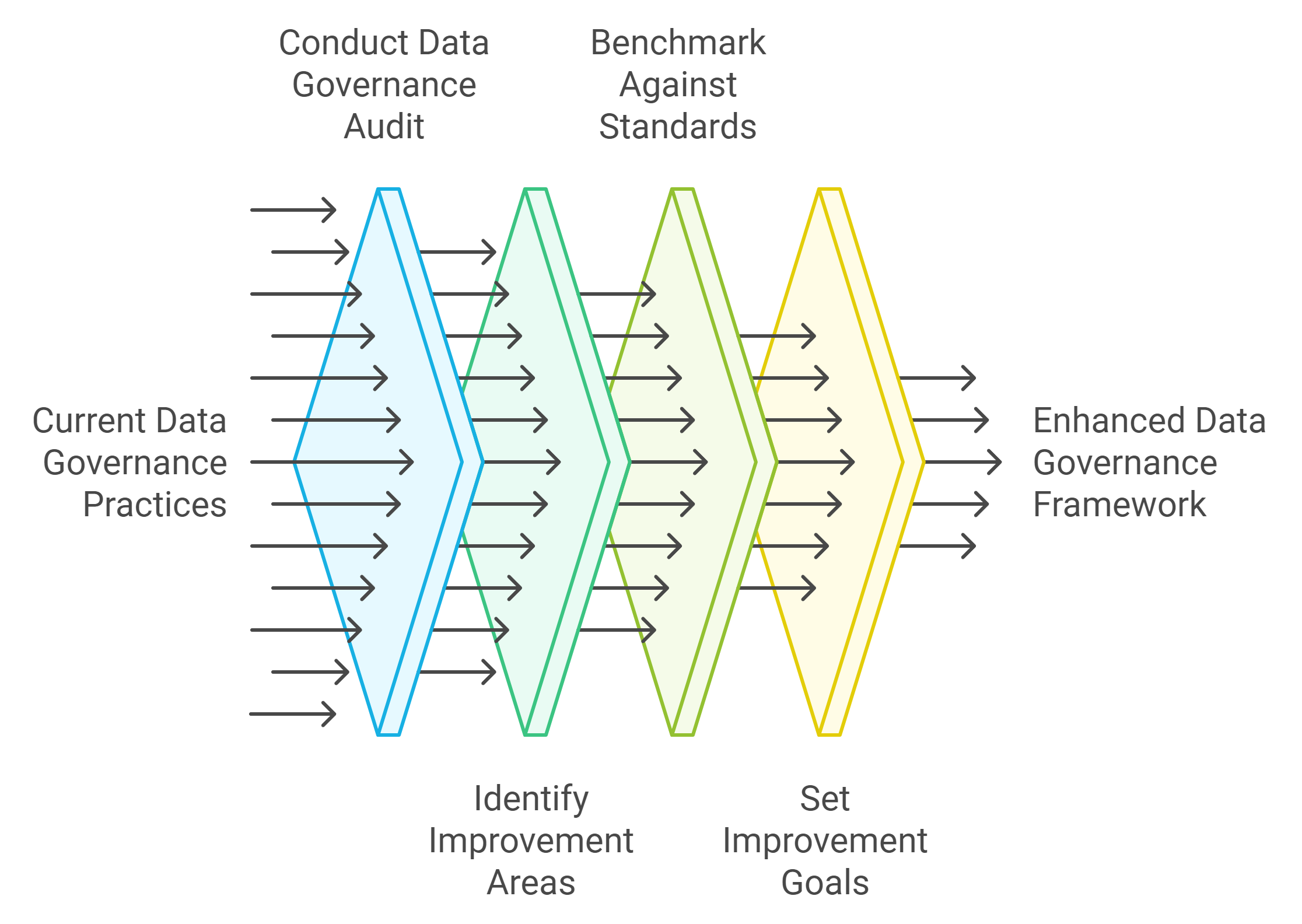
Conducting a Data Governance Audit
A data governance audit helps you evaluate your current practices and identify areas for improvement. Start by reviewing your organization's data policies, processes, and tools. Assess whether these align with your business objectives and support your operational needs. Look for gaps in data quality, security, and accessibility. For example, inconsistent data formats or outdated security protocols can hinder your ability to make informed decisions.
Create a checklist to guide your audit process. Include key areas such as:
Data Quality: Are your datasets accurate, complete, and consistent?
Data Security: Do your security measures protect sensitive information effectively?
Data Accessibility: Can authorized users access the data they need without delays?
Compliance: Are your practices aligned with regulations like GDPR or HIPAA?
Document your findings and prioritize the issues that need immediate attention. Addressing these gaps ensures that your data governance framework supports your business goals effectively. Regular audits also help you stay proactive in identifying risks and opportunities for improvement.
"Conducting a thorough audit of your data governance practices is essential for maintaining data integrity and aligning with organizational objectives."
Benchmarking Against Industry Standards
Benchmarking allows you to compare your data governance practices with industry standards and best practices. This process helps you measure the maturity of your governance framework and identify areas where you can improve. Start by researching benchmarks specific to your industry. Look for metrics related to data quality, compliance, and operational efficiency.
Evaluate your current capabilities against these benchmarks. For instance, if industry leaders achieve 95% data accuracy, assess how your organization measures up. Identify gaps and set realistic goals to close them. Use key performance indicators (KPIs) to monitor your progress. Examples of KPIs include:
Percentage of accurate and complete data records.
Time taken to resolve data-related issues.
Compliance rates with industry regulations.
Benchmarking also highlights best practices that you can adopt. For example, some organizations use automated tools to streamline data management and reduce errors. Implementing similar strategies can enhance your governance framework and improve overall performance.
"Aligning your data governance practices with industry benchmarks ensures that your organization remains competitive and compliant."
By conducting audits and benchmarking against industry standards, you create a roadmap for continuous improvement. These steps not only enhance your data governance framework but also ensure that it aligns with your business objectives. This alignment enables you to unlock the full potential of your data as a strategic asset.
Building a Cross-Functional Approach to Align Data Governance
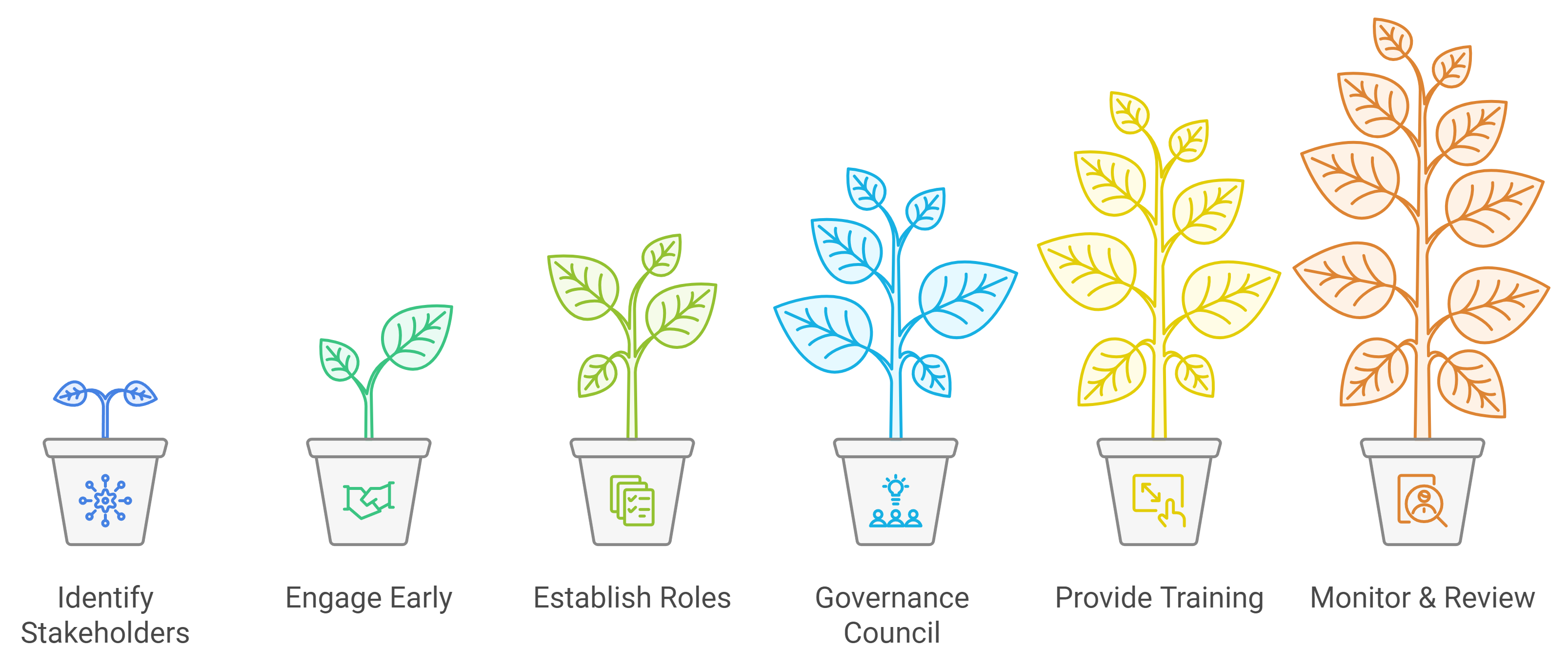
Involving Key Stakeholders Across Departments
To successfully align data governance with your business objectives, you must involve key stakeholders from various departments. Each department interacts with data differently, so their input ensures that your governance framework addresses diverse needs. Engaging stakeholders early fosters a sense of ownership and commitment to the initiative.
Start by identifying the primary stakeholders in your organization. These may include leaders from IT, finance, marketing, operations, and compliance. Schedule meetings to discuss how data governance impacts their roles and responsibilities. Highlight the benefits, such as improved efficiency, better decision-making, and enhanced compliance. Use real-world examples or success stories to demonstrate the value of aligning data governance with business goals.
“Engaging stakeholders early on generates a sense of ownership and aligns governance efforts with organizational goals,” says a data governance expert.
Encourage open communication during these discussions. Create a platform where stakeholders can share their concerns, expectations, and ideas. This collaborative approach builds trust and ensures that everyone feels heard. When stakeholders see how data governance supports their objectives, they are more likely to champion the initiative within their teams.
Quick wins can also motivate stakeholders. For example, implement a small project that demonstrates the immediate benefits of data governance, such as improving data accuracy in a specific process. These early successes reinforce the value of the initiative and encourage continued participation.
Establishing Clear Roles and Responsibilities
A cross-functional approach requires clarity in roles and responsibilities. Without defined roles, confusion can arise, leading to inefficiencies and delays. Assigning accountability ensures that every aspect of data governance is managed effectively.
Begin by mapping out the data governance tasks within your organization. These may include data quality management, compliance monitoring, and access control. Assign each task to a specific role or team. For instance, IT may handle data security, while marketing ensures the accuracy of customer data. Clearly document these responsibilities to avoid overlap or gaps.
Establish a governance council or steering committee to oversee the initiative. This group should include representatives from all key departments. Their role is to provide strategic direction, resolve conflicts, and ensure alignment with business objectives. Regular meetings keep everyone informed and aligned.
“Defining roles and responsibilities builds a strong foundation for data governance,” notes a chief data officer.
Provide training to help stakeholders understand their roles. Educate them on the importance of data governance and how it impacts their work. Use workshops, webinars, or one-on-one sessions to address specific needs. When stakeholders feel confident in their roles, they contribute more effectively to the initiative.
Finally, monitor and review these roles regularly. As your organization evolves, so will your data governance needs. Adjust responsibilities to reflect changes in business priorities or regulatory requirements. This flexibility ensures that your governance framework remains relevant and effective.
Overcoming Challenges in Aligning Data Governance
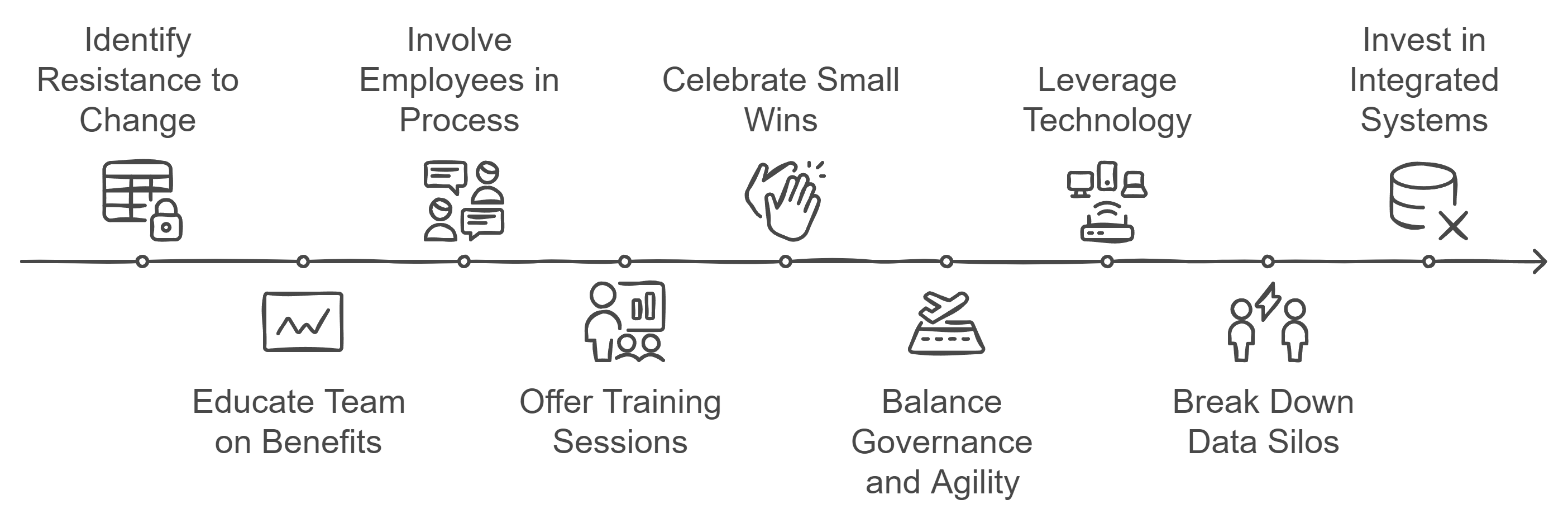
Addressing Resistance to Change
Resistance to change often emerges as one of the biggest hurdles when implementing or aligning data governance initiatives. People may feel uncertain about new processes or fear that changes will disrupt their daily workflows. To address this, you need to focus on creating a culture that values data and its role in achieving business objectives.
Start by educating your team about the benefits of aligning data governance with business goals. Use clear examples to show how improved data quality and accessibility can enhance decision-making and operational efficiency. Highlight success stories from other organizations that overcame similar challenges. For instance, emphasize how promoting the value of data and rewarding contributions to governance initiatives fosters a data-centric environment.
Engage employees at all levels by involving them in the process. Encourage open discussions where they can voice concerns and provide feedback. This inclusive approach builds trust and reduces resistance. Additionally, offer training sessions to improve data literacy. When employees understand how data governance supports their roles, they are more likely to embrace the changes.
“Promoting data literacy and creating a data-centric environment helps reduce resistance and fosters collaboration,” says a data governance expert.
Celebrate small wins to maintain momentum. For example, showcase how a new governance policy improved data accuracy or reduced errors in a specific department. These quick successes demonstrate the value of the initiative and motivate others to support it.
Balancing Governance with Agility
Striking the right balance between governance and agility is essential for success. Overly rigid governance frameworks can stifle innovation and slow down decision-making. On the other hand, too much flexibility can lead to inconsistencies and data quality issues. To achieve this balance, you need to design a governance framework that adapts to your organization’s needs without compromising its core principles.
Focus on creating policies that prioritize both structure and flexibility. For instance, establish clear guidelines for data access and security while allowing teams to customize workflows based on their specific requirements. This approach ensures that governance supports, rather than hinders, your business operations.
Leverage technology to streamline governance processes. Automated tools can help enforce policies, monitor compliance, and maintain data quality without adding unnecessary complexity. For example, use software to track data usage and flag potential issues in real time. This reduces manual effort and allows your team to focus on strategic tasks.
Regularly review your governance framework to ensure it remains relevant. Business needs evolve, and your governance practices should adapt accordingly. Schedule periodic assessments to identify areas for improvement and make adjustments as needed. This iterative approach helps you maintain a balance between governance and agility.
“Balancing governance with agility ensures that data governance supports innovation while maintaining data integrity,” notes a chief data officer.
Breaking Down Data Silos
Data silos occur when departments or teams store data in isolated systems, making it difficult to share or access information across the organization. These silos hinder collaboration, reduce efficiency, and limit the value of your data. To break down these barriers, you need to promote a culture of transparency and collaboration.
Start by defining clear data ownership, accountability, and stewardship roles. Assign specific individuals or teams to oversee data management tasks and ensure consistency across departments. This clarity streamlines decision-making processes and prevents silos from forming.
Encourage cross-departmental collaboration by creating opportunities for teams to work together on data-related projects. For example, organize workshops or brainstorming sessions where employees can share insights and identify ways to improve data sharing. Highlight the benefits of collaboration, such as faster decision-making and improved customer experiences.
Invest in integrated data management systems that centralize information and make it accessible to authorized users. These systems eliminate the need for separate databases and ensure that everyone works with the same accurate and up-to-date data. Additionally, establish policies that promote data sharing while maintaining security and compliance.
“By defining clear data ownership and fostering collaboration, organizations can avoid silos that hinder innovation and efficiency,” says a data governance consultant.
Breaking down data silos not only improves operational efficiency but also enhances your ability to align data governance with business objectives. When teams work together and share information, your organization can unlock the full potential of its data as a strategic asset.
Measuring the Impact of Aligned Data Governance
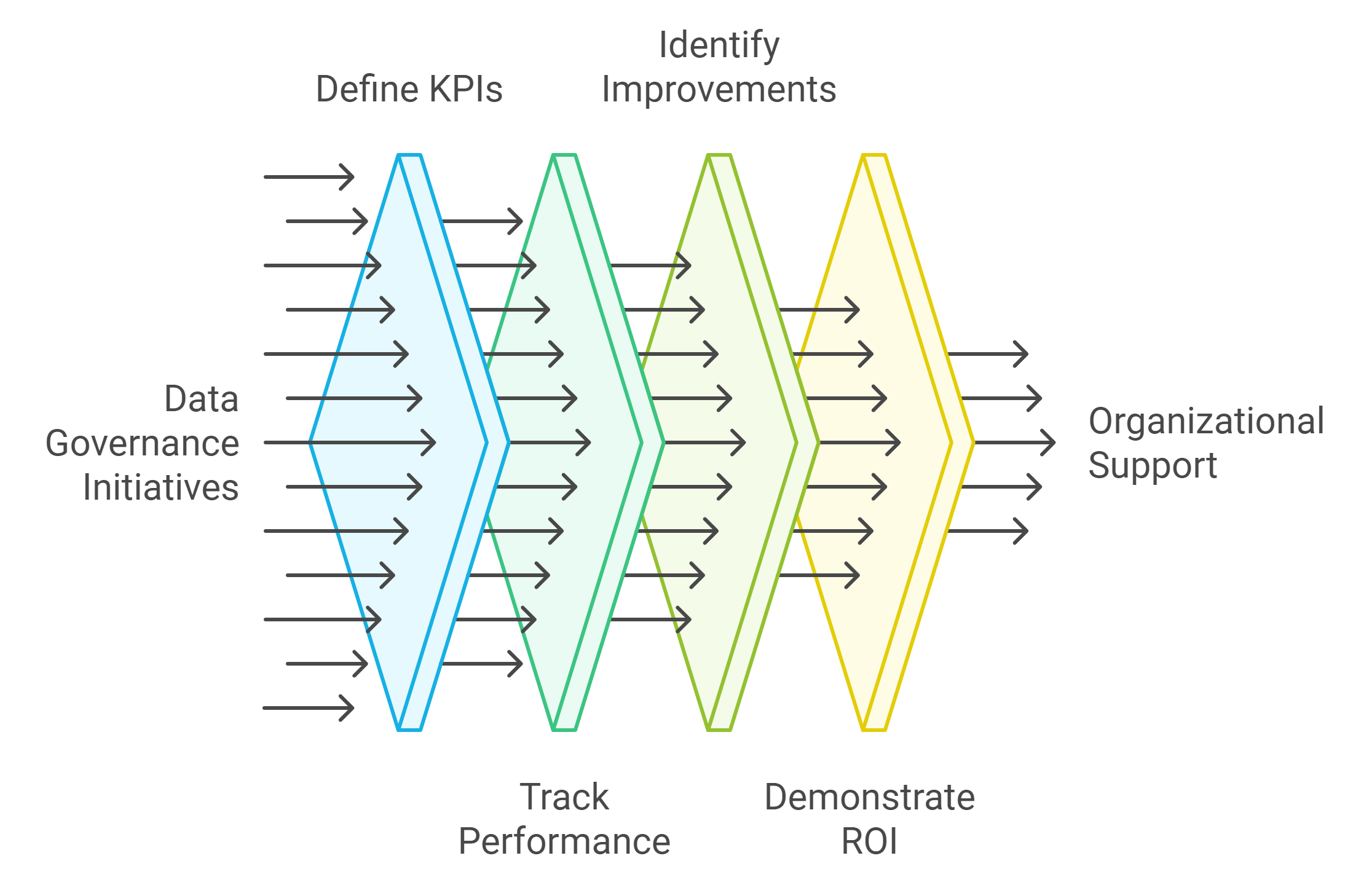
Key Performance Indicators (KPIs) for Success
Measuring the success of your data governance efforts requires clear and actionable Key Performance Indicators (KPIs). These metrics help you evaluate how well your governance framework aligns with your business objectives. By tracking KPIs, you can identify areas of improvement and demonstrate the value of your initiatives.
Here are some essential KPIs to consider:
Data Accuracy Rate: Measure the percentage of accurate data within your systems. High accuracy ensures reliable decision-making. For example, financial services companies often achieve over 85% accuracy after implementing robust governance tools.
Data Accessibility: Track how quickly authorized users can access the data they need. Faster access improves operational efficiency and supports timely decision-making.
Compliance Rate: Monitor adherence to regulations like GDPR or HIPAA. A high compliance rate reduces legal risks and builds trust with stakeholders.
Resolution Time for Data Issues: Measure the average time it takes to resolve data-related problems. Shorter resolution times indicate effective governance practices.
Cost Savings: Evaluate the reduction in operational costs due to streamlined data management. Organizations that align data governance with their objectives often save up to 20% in operational expenses.
“Defining and tracking KPIs ensures that your data governance efforts remain focused and deliver measurable results,” says a data governance expert.
Regularly review these KPIs to assess the effectiveness of your governance framework. Use the insights to refine your strategies and ensure continuous improvement.
Demonstrating ROI Through Case Studies and Metrics
Proving the return on investment (ROI) of data governance is crucial for gaining organizational support. Case studies and metrics provide tangible evidence of the benefits, helping you justify the resources allocated to governance initiatives.
Start by collecting data on the outcomes of your governance efforts. Focus on metrics like cost savings, improved efficiency, and enhanced decision-making. For instance, organizations that align data governance with their business goals often reduce data errors by 50%, leading to significant operational improvements.
Use real-world examples to illustrate the impact. For example:
A retail company improved customer satisfaction by ensuring accurate and accessible customer data. This led to a 15% increase in repeat purchases.
A financial services firm achieved 85% data accuracy, reducing compliance risks and saving millions in potential fines.
Present these case studies in a clear and compelling format. Highlight the challenges faced, the actions taken, and the results achieved. Use visuals like charts or graphs to make the data more engaging and easier to understand.
“Case studies and metrics provide undeniable proof of the value of data governance, making it easier to secure buy-in from stakeholders,” notes a chief data officer.
By demonstrating ROI, you not only validate your efforts but also build a strong case for continued investment in data governance. This approach ensures that your organization recognizes the strategic importance of aligning data governance with business objectives.
The Benefits of Aligning Data Governance with Business Objectives

Improved Decision-Making Through High-Quality Data
High-quality data forms the backbone of effective decision-making. When you align data governance with your business objectives, you ensure that your organization relies on accurate, consistent, and reliable data. This alignment eliminates errors and inconsistencies that could otherwise lead to poor decisions. For instance, standardized data definitions and roles help you access the right information at the right time, enabling faster and more informed choices.
By implementing robust data governance practices, you enhance visibility into your data assets. This transparency allows you to identify trends, uncover opportunities, and address challenges proactively. For example, businesses that prioritize data quality often experience a 50% reduction in data-related errors, leading to better strategic outcomes. With high-quality data, you can confidently make decisions that drive growth and innovation.
"Well-governed data leads to better decision-making processes and decisions based on the right data."
Enhanced Operational Efficiency and Cost Savings
Aligning data governance with your business objectives streamlines operations and reduces redundancies. By optimizing processes and ensuring predictable data access, you save valuable time and resources. For example, organizations that eliminate duplicate data and standardize workflows often achieve significant cost savings. Studies show that companies aligning data governance with their goals can save up to 20% in operational expenses.
Efficient data management also minimizes errors in your database, reducing the time spent on corrections. This efficiency allows your team to focus on value-driven activities rather than repetitive tasks. Additionally, integrated data systems improve collaboration across departments, further enhancing productivity. When you align data governance with your objectives, you create a foundation for smoother operations and measurable cost reductions.
"Data governance acts as a catalyst for time and resource savings through optimized processes and reduced redundancies."
Strengthened Compliance and Risk Management
Regulatory compliance is a critical aspect of modern business operations. Aligning data governance with your objectives ensures adherence to laws like GDPR, HIPAA, or industry-specific regulations. This alignment reduces the risk of fines and legal complications while building trust with stakeholders. For example, organizations with strong governance frameworks often achieve higher compliance rates, safeguarding their reputation and financial stability.
Effective data governance also enhances security by protecting sensitive information from breaches. By implementing clear policies and monitoring data usage, you mitigate risks and maintain data integrity. Furthermore, compliance-focused governance fosters accountability, ensuring that every department understands its role in managing data responsibly. This proactive approach strengthens your organization’s ability to navigate regulatory landscapes confidently.
"Data governance provides superior compliance capabilities, ensuring that organizations meet regulatory requirements and protect sensitive information."
Aligning data governance with your business objectives is essential for driving organizational success. Start by identifying your core goals, assessing current practices, and implementing a governance framework tailored to your priorities. These steps ensure that your data governance efforts directly support measurable outcomes. By doing so, you unlock benefits like improved decision-making, enhanced operational efficiency, and strengthened compliance. Take the first step today—evaluate your current strategies and align data governance with your business goals to maximize its value as a strategic asset.
See Also
Comprehensive Approach to Developing a Data Governance Plan
Understanding Data Governance: Key Concepts and Methods
Synchronizing Data Teams with Organizational Goals
Incorporating Data Leadership Within Business Governance
How Data Governance Contributes to Maintaining Data Integrity
